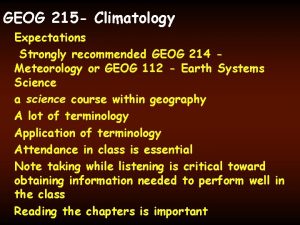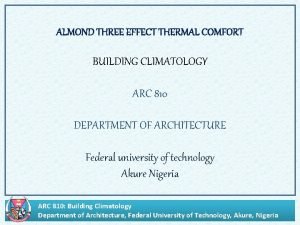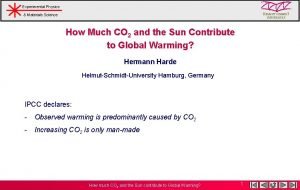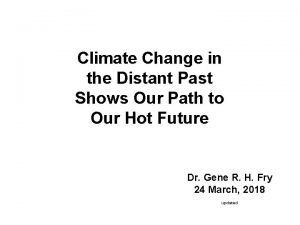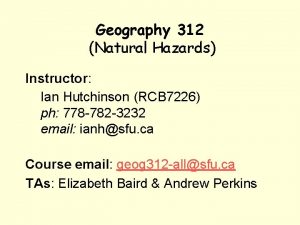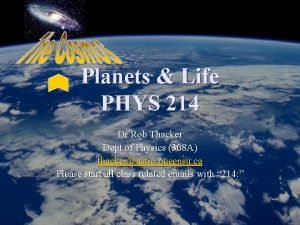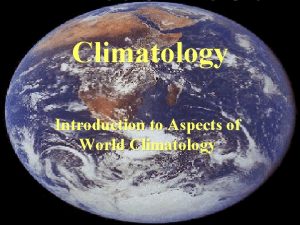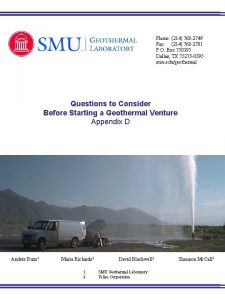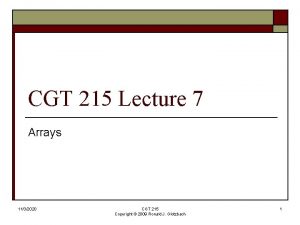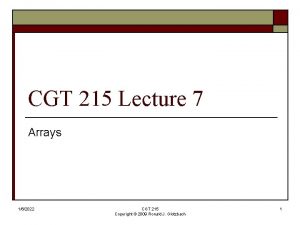GEOG 215 Climatology Expectations Strongly recommended GEOG 214





























- Slides: 29

GEOG 215 - Climatology Expectations Strongly recommended: GEOG 214 -Meteorology OR GEOG 112 - Earth Systems Science a science course within geography discipline A lot of terminology Application of terminology Attendance in class is essential Note taking while listening is critical toward obtaining information needed to perform well in the class Reading the chapters is important

Course structure 3 exams and a number of class assignments - exams 1 and 2 are worth 125 points - Final exam is worth 200 points semi-comprehensive ~55% new content ~45% old content exams are curved up to 10% of total pts based on the highest score achieved -class assignments are worth 50 points total Total points for course = 500 points

Exam curve Example 1 The highest score is 119 out of 125 points. The curve would be 6 points. Thus everyone has 6 points added to their score, making the top score 100% or 125 pts Example 2 The highest score is 99 out of 125 points. The curve would be 12. 5 points or 10% of 125 possible. Thus everyone gets 12. 5 points added to their score, making the top score 89% or 111. 5 points

Exam dates are fixed and will not be changed. They are: Exam 1 - Tuesday, February 11, 2014 1: 30 -2: 45 PM Exam 2 - Tuesday, March 25, 2014 1: 30 -2: 45 PM Final Exam- Thursday, May 1, 2014 1: 30 -3: 30 PM Legitimate reasons to miss an exam (academics, athletics, illness) - you must inform me at least one week before the scheduled exam to make arrangements for the make up exam. Illness- call me or email within 24 hours. Make ups are given at times of my choosing. The final exam will not be rescheduled to accommodate travel plans for students wishing to leave early for summer break.

��������������� ’������� � a����� as much as we might like to. ��������������� re is a���������������. This is a concern to scientists, and educators as it demonstrates a lower level of scientific literacy than is desirable

Chapter 1 Climatology? What is it, and why is it important? It is the study of long term interactions of Earth’s atmosphere (temperature, pressure, wind speed and direction, & moisture) with solar energy (exosphere), oceanic variations (hydrosphere), geological variables like volcanic eruptions (geosphere) and the influence of biological organisms (biosphere). • Atmosphere-One of the critical components on our planet. It functions as… • Thermal regulator- movement of energy from areas with excess (Equatorial) to areas with limited amounts (Polar). • Protective shield- prevents, limits or alters harmful materials from reaching the Earth. • Essential for Respiration- Most Living organisms (plant and animal) require interaction with gases in the atmosphere

Important fields of Study within the atmospheric sciences • Aerology- study of the structure and chemical and physical interactions of the various components in the atmosphere. - typically incorporated into other two fields • Meteorology- deals with air mass motion, air mass characteristics such as temperature, moisture and pressure, and weather phenomena such as storms, on a short (seconds, minutes, hours, days, weeks) time scale. • Climatology- the same as with meteorology only over a longer (Months, years, decades, millennia) time scale. Both average and extreme conditions

these are very important this is Often misconstrued by the public

Atmospheric variables • • • Air Temperature: units -> C, F, K Clouds: type, height (elevation) amount Barometric pressure: bar, millibar, mm or in Dew Point Temperature: F or C Precipitation: kind (rain, snow sleet, etc. , and amount inches or cm • Wind velocity and direction: – Velocity (MPH, Knots, Km. PH) and – Direction (N, S, E, W, NE, SW) • Degree of sunshine: qualitative estimate – e. g. , partly sunny; mostly cloudy, etc. These constitute the Current or Prevailing Weather conditions


Parts per million Percentage of total Nitrogen (N 2) 780, 840 78. 1% Oxygen (O, O 2) 209, 460 20. 9% 9, 340 0. 9% 350 0. 035% Neon (Ne) 18 0. 0018% Helium (He) 5. 2 0. 00052% Methane (CH 4) 1. 4 0. 00014% 1 0. 0001% Nitrous Oxide (NOx) 0. 5 0. 00005% Hydrogen (H 2) 0. 5 0. 00005% Xenon (Xe) 0. 09 0. 000009% Ozone (O 3) 0. 07 0. 000007% Gas Argon (Ar) Carbon Dioxide (CO 2) Kryton (Kr)


Constant gases relative proportions of these gases remains constant vertically to around 80 km many of these are present in small amounts Most important abundant constant gases are Nitrogen- relatively inactive Oxygen - very active Argon - very inactive Variable gases The concentrations vary throughout time and space e. g. , Ozone, CO 2, Water Vapor

Development of Atmosphere (and therefore weather and climate!) Early Earth’s atmosphere (Precambrian) proto Earth (~5 -4. 5 by) was largely Hydrogen and Helium these were likely stripped away until the proto earth’s core stabilized and the materials differentiated enough to create a magnetosphere - protection from solar wind Volcanic gasses altered the early Earth’s (~4. 6 to 4. 3 by) atmospheric composition enriched in H 2 CO 2, SO 2, NH 3, CH 4, CO, S 2 Cl 2 No free Oxygen (O, O 2) or Ozone (O 3) Some O and O 2 production early (4. 5 by-700 my) due to photochemical reactions between H 2 O and UV radiation Yields the beginnings of the stratospheric ozone layer Blue green algae and cyanobacteria altered the Earth’s atmosphere (4. 2 by - 700 my) consuming CO 2 and producing the highly reactive gas Oxygen as a product of photosynthesis Changes chemistry of Earth’s atmosphere and oceans significantly O 2 And CO 2 levels fluctuate dramatically during the last 500 my

Periodic table of elements Yellow indicates elemental gases at Earth’s temp ranges by combining gas elements with non gasses, it is possible to create gaseous molecules like CO 2, CO and others.


Climogram -an example of a plot relating temp and moisture Each color represents a month Temperature (°F) 80 60 40 20 2 3 4 Precipitation per month (in) 5

Gas Laws Boyles’ first law: Po. Vo=P 1 V 1 = k Pressure = P; Volume=V; Constant= k 0= time 1; 1= time 2 an increase in pressure results in a decrease in volume and vice versa Boyles’ second law: P/D = k D= Density As pressure increases so does the density of the gas Assumes that the constant k deals with temperature and other variables being held constant between measurements.

Gay-Lussac’s Law Relates Temperature (t) and Volume (Vx) with pressure constant Vt = Vo(1+t/273) where Vt is a volume at temperature t in (C) and Vo is the volume at temperature 0° C. Charles’ law Relationship between Pressure and Temperature when Volume is constant Pt = Po (1+ t /273) Pt is a pressure at temperature t in (C) and Po is the pressure at temperature 0° C.

Structure: Atmosphere has discrete zones each with specific characteristics Atmosphere is base loaded- most stuff is present in higher amounts in the lower zones



Troposhpere/Tropopause The lowermost part of the atmosphere Most turbulent vertical and horizontal air motion Variable height Poles: 9 -12 Km Equator: 16 -18 km -Most moisture here -thus most cloud cover in this layer Area of active weather This is the area with most meteorological phenomena Separated from over lying layer by a zone of overlapping zones called the Tropopause Can be seen as towering clouds encounter this boundary and get sheared off in the next layer Think of a reason WHY it does this?

������� punching through the Tropopause into the Stratosphere�

Stratosphere /Stratopause Stable dry and little vertical motion Lowermost region in Stratosphere has high velocity horizontal winds jetstreams are located here Temperature remains constant throughout most of the stratosphere still cold though!!! Ozone layer (ozonosphere) resides primarily in this zone Separated from overlying layer by the Stratopause overlapping zones create this boundary mostly determined by temperature change


Mesosphere Decreasing temperature with altitude the mesosphere is part of a thicker layer or zone called the ionosphere Ionosphere created by the Sun’s incoming radiative energy the radiation strips electrons from atoms ions interact with other ions incoming and encountered in the atmosphere creates some interesting phenomena Aurora Borealis (Northern and Southern Lights) interference with electrical systems on Earth


Above the Mesosphere exist several zones with discrete elemental compositions The lowermost part (up to ~120 km) of these zones is called the Thermosphere Otherwise they are referred to by their gaseous composition e. g. , Nitrogen, Oxygen, Helium, and Hydrogen
 Geog 214
Geog 214 Ashrae comfort chart
Ashrae comfort chart Hermann harde
Hermann harde International satellite cloud climatology project
International satellite cloud climatology project Sentenza n. 215/87 della corte costituzionale
Sentenza n. 215/87 della corte costituzionale Tc 215
Tc 215 10000000/215
10000000/215 Economic 215
Economic 215 Energy physics definition
Energy physics definition Completed ics 215 form
Completed ics 215 form Estimate word problems
Estimate word problems Eecs 627
Eecs 627 Dtu-215
Dtu-215 Guggisberg 10 year development plan
Guggisberg 10 year development plan Http //servsoc/inicio.aspx
Http //servsoc/inicio.aspx Ley 40/215
Ley 40/215 Tangent ratios
Tangent ratios Stc 215/1994
Stc 215/1994 Po box 1220 philadelphia pa 19105
Po box 1220 philadelphia pa 19105 The formula c=5p+215 relates c
The formula c=5p+215 relates c Geog 312 sfu
Geog 312 sfu Dse geog essay sample
Dse geog essay sample Unit 1 geog. of ga/ga’s beginnings
Unit 1 geog. of ga/ga’s beginnings Geog
Geog Free floating subdivisions
Free floating subdivisions Present perfect verbs
Present perfect verbs Rdc 214 de 2006
Rdc 214 de 2006 Phys 214
Phys 214 214 en binario
214 en binario Whizz wheel
Whizz wheel
